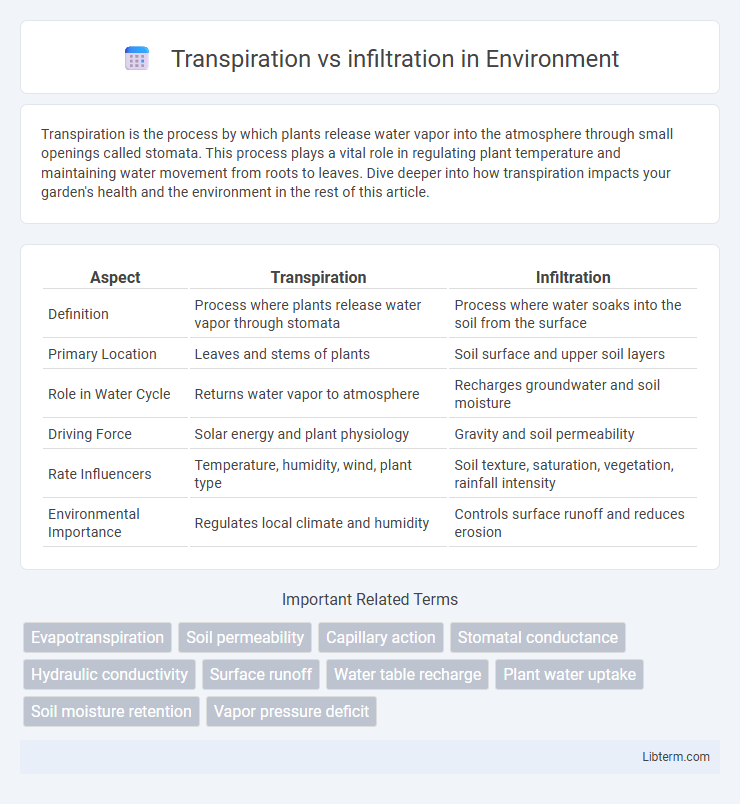Transpiration is the process by which plants release water vapor into the atmosphere through small openings called stomata. This process plays a vital role in regulating plant temperature and maintaining water movement from roots to leaves. Dive deeper into how transpiration impacts your garden's health and the environment in the rest of this article.
Table of Comparison
| Aspect | Transpiration | Infiltration |
|---|---|---|
| Definition | Process where plants release water vapor through stomata | Process where water soaks into the soil from the surface |
| Primary Location | Leaves and stems of plants | Soil surface and upper soil layers |
| Role in Water Cycle | Returns water vapor to atmosphere | Recharges groundwater and soil moisture |
| Driving Force | Solar energy and plant physiology | Gravity and soil permeability |
| Rate Influencers | Temperature, humidity, wind, plant type | Soil texture, saturation, vegetation, rainfall intensity |
| Environmental Importance | Regulates local climate and humidity | Controls surface runoff and reduces erosion |
Introduction to Transpiration and Infiltration
Transpiration is the biological process where plants absorb water from the soil, transport it through their vascular system, and release it as water vapor through stomata in the leaves. Infiltration refers to the movement of surface water into the soil, where it replenishes groundwater and supports plant growth. Both processes play crucial roles in the hydrological cycle, influencing soil moisture levels and ecosystem sustainability.
Definition of Transpiration
Transpiration is the process where water absorbed by plant roots is evaporated into the atmosphere through small pores called stomata on leaves. It plays a critical role in the water cycle by regulating moisture levels and facilitating nutrient movement within plants. Unlike infiltration, which involves water seeping into the soil, transpiration specifically relates to water vapor release from living vegetation.
Definition of Infiltration
Infiltration is the process by which water on the ground surface enters the soil, moving downward through the soil pores and cracks. This hydrological mechanism is crucial for replenishing groundwater, reducing surface runoff, and maintaining soil moisture essential for plant growth. Unlike transpiration, which involves water vapor release from plants, infiltration directly impacts water absorption and storage within the terrestrial ecosystem.
Processes Involved in Transpiration
Transpiration is the process where water absorbed by plant roots moves through xylem vessels to leaf stomata and evaporates into the atmosphere. This process involves water uptake, cohesion and adhesion within xylem, and stomatal regulation controlling water release. Unlike infiltration, which concerns water penetrating soil, transpiration actively drives water movement through plant vascular systems, influencing the hydrological cycle.
Processes Involved in Infiltration
Infiltration involves the process by which water on the ground surface enters the soil, primarily driven by soil texture, structure, and moisture content. Key factors affecting infiltration include the permeability of soil layers, surface slope, and vegetation cover that enhance water absorption and reduce runoff. This process is crucial for groundwater recharge, soil moisture maintenance, and reducing surface erosion.
Key Differences Between Transpiration and Infiltration
Transpiration is the biological process where water absorbed by plant roots is evaporated into the atmosphere through leaf pores, playing a crucial role in the water cycle and plant physiology. Infiltration refers to the process of water soaking into the soil from the surface, affecting groundwater recharge and soil moisture levels. Key differences include that transpiration involves living organisms and water vapor release, whereas infiltration involves the physical movement of water through soil, impacting hydrological dynamics differently.
Factors Affecting Transpiration
Transpiration rates are primarily influenced by environmental factors such as temperature, humidity, wind speed, and light intensity, each modulating the rate of water vapor loss through plant stomata. Soil moisture availability directly impacts transpiration, as insufficient water limits stomatal opening, reducing water loss. Plant-specific factors like leaf area, stomatal density, and species adaptation also determine the efficiency and rate of transpiration in different environments.
Factors Affecting Infiltration
Soil texture, structure, and moisture content significantly influence infiltration rates by determining the soil's permeability and ability to absorb water. Vegetation type and land cover affect infiltration through root systems that create soil pores and organic matter that enhances soil aggregation. Surface conditions like compaction, crusting, and slope gradient also play critical roles in reducing or facilitating the movement of water into the soil.
Role in the Water Cycle
Transpiration transfers water from plants to the atmosphere, contributing to cloud formation and precipitation within the water cycle. Infiltration allows water to penetrate the soil, replenishing groundwater and maintaining soil moisture necessary for plant growth. Both processes regulate water distribution between the atmosphere, surface, and underground reservoirs, ensuring ecosystem stability.
Environmental Significance of Transpiration and Infiltration
Transpiration plays a critical role in regulating the water cycle by releasing water vapor into the atmosphere, which helps maintain local humidity and supports cloud formation essential for precipitation. Infiltration facilitates groundwater recharge by allowing surface water to penetrate soil layers, reducing runoff and preventing soil erosion, thereby sustaining aquifers and maintaining ecosystem health. Both processes contribute significantly to water conservation and climate regulation, ensuring the stability of terrestrial and aquatic habitats.
Transpiration Infographic

 libterm.com
libterm.com